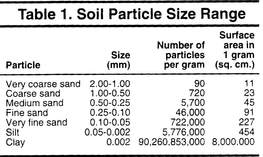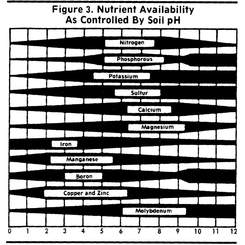Basic Gardening Notes
This section is going to be a bit more scattered in its organization than the design section. However, the basis for all gardening is the soil, so let's start there!
Soils 101
Whole classes are taught on soil so, obviously, this will not be a complete review of the subject. But it may help you understand a bit better how to give your plants the best shot possible at a long and healthy life. Soil is a complex mixture of organic and inorganic chemicals plus lots of living things. It serves as a major source of both water and nutrients that your plants need to grow.
Soils 101
Whole classes are taught on soil so, obviously, this will not be a complete review of the subject. But it may help you understand a bit better how to give your plants the best shot possible at a long and healthy life. Soil is a complex mixture of organic and inorganic chemicals plus lots of living things. It serves as a major source of both water and nutrients that your plants need to grow.

Soils differ in the size of particles and their chemical nature. The most direct effect of particle size is drainage of water through the soil. Sandy soils drain very quickly and can allow up to 2" of water to infiltrate per hour while soils with a lot of clay drain poorly and only allow about 0.2" per hour. Clayey soils also tend to crack open when dry. Obviously plants don't do well when this happens!

Soil particle size also affects how well the soil holds and gives up plant nutrients. Sandy soils don't hang on to nutrients well but clay soils do. Soil pH controls the availability of plant nutrients also. Very low pH (more acid) or high pH (more alkaline) soils hinder the conversion of many plant nutrients from an unavailable form to a form the plants can use. The best pH for plants is neutral, or between 6.5 and 7 but most plants will tolerate a range from 6 to 7.5.
The most important plant nutrients are Nitrogen, Phosphorous and Potassium, usually expressed as NPK. Most fertilizers you can buy will have at least these elements listed. Magnesium, Iron, Calcium and Sulphur are also important to plants.
The most important plant nutrients are Nitrogen, Phosphorous and Potassium, usually expressed as NPK. Most fertilizers you can buy will have at least these elements listed. Magnesium, Iron, Calcium and Sulphur are also important to plants.
While sand, silt and clay along with soil chemistry are the non-living part of soil, the living parts are equally important. They include worms, soil insects, algae, fungi and bacteria. These organisms help convert the organic forms of the nutrients listed above into an inorganic form that the plants can use.
Before spending much time or energy on planting, ordering a soil test is wise. It will give you a starting point when trying to figure out what to plant where and how best to amend your soil depending on what you want to grow there. Every state has a land grant university with a soil testing lab. Information on soil testing can also be found at your local Cooperative Extension Service.
Before spending much time or energy on planting, ordering a soil test is wise. It will give you a starting point when trying to figure out what to plant where and how best to amend your soil depending on what you want to grow there. Every state has a land grant university with a soil testing lab. Information on soil testing can also be found at your local Cooperative Extension Service.
Coming Soon: Amending the soil
